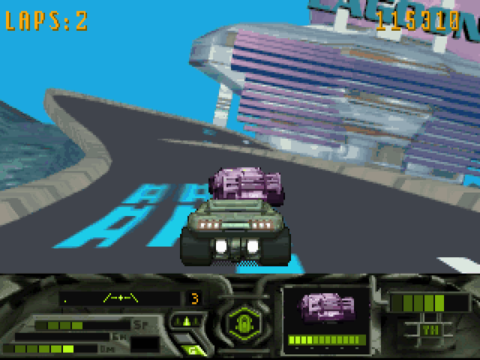
MegaRace
Written by: Rik
Date posted: June 9, 2009
- Genre: Racing
- Developed by: Cryo
- Published by: The Software Toolworks
- Year released: 1993
- Our score: 2
With one exception, the setup for MegaRace, described at length during the game’s introduction sequence, is fairly straightforward. In the future, MegaRace is an ultra-violent TV show where, we’re informed by the show’s “mega-host”, Lance Boyle, a member of the public (known as ‘The Enforcer’) races against no-good street gangs on specially constructed tracks, all for the viewer’s enjoyment. It’ll all be very exciting, and jolly dangerous, too – there’ll be collisions, weapons and everything.
It all sounds rather like The Running Man (if you’ve seen it, and guessing the likely demographic for this web-site, I’m almost certain that you have) – or indeed any one of a number of games or movies involving a violent, futuristic TV show. Having gleefully described the amount of carnage and bloodshed that’s about to ensure, however, our host then adds a slightly confusing postscript: none of the show is real, and nobody actually dies. Everything is taking place on something called “Virtual Television”, which is apparently “reality’s worst nightmare”. Whatever that means.
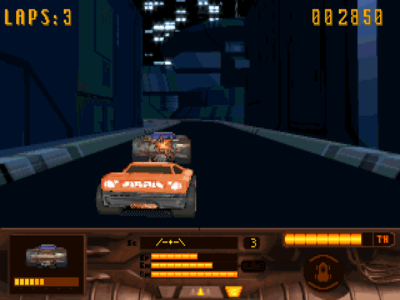
This orange monstrosity is one of the early vehicles at your disposal. Some of the cars have names like ‘Luis’ and ‘Maria’ – which is a bit odd, I reckon.
If I understand this correctly, though, by playing this game you are pretending to be a contestant on a fake futuristic TV show where the contestants are themselves pretending to race against pretend vicious speed gangs, with no dangerous consequences whatsoever. And this is the number one show on television? Frankly, it sounds even less exciting than actual real-life shows that were popular at the time; I mean, in Gladiators you’d at least get the occasional twisted ankle or sore knee, not to mention at least one foam pugil stick in the face per show. And that’s a REAL foam pugil stick in someone’s ACTUAL face, none of this sissy virtual stuff.
Still, it’s altogether appropriate that words like “virtual”, “nightmare” and “worst” should appear so readily at the start, as they handily give the player an idea of what to expect from the game itself. True to its word, MegaRace gives you virtuality instead of reality – a rolling animation of a road with a few sprites skating around on top of it, and minimal control over either.
Okay, let’s rewind a bit. MegaRace was released at a time when games on CD were a novelty and developers were falling over themselves to make use of all the extra storage space, shoehorning in flashy animated scenes and video sequences here and there in an attempt to woo the public. In MegaRace, though, not only do we get plenty of Lance Boyle (and boy, do we get plenty of Lance Boyle) between races, but the races themselves involve an animated sequence spooled directly from the CD. The advantage of this, at the time, was that you got in-game graphics that were amazing to look at, and for once didn’t represent a disappointment after the flashy intro.
On the negative side, though, it tended to limit what you could actually do with the game itself. In MegaRace’s case, the employment of this rather questionable technology leaves us with a game that’s laughably basic – a paper thin, sub-Space Invaders mini-game that might be mildly entertaining if it appeared on your mobile phone (and you were extremely bored).
Here’s what the ‘game’ involves. You start at the beginning of the moving road animation. Your car is represented by a car-shaped sprite floating on top of the animation, which, after a brief countdown, starts juddering into life. You can’t stop your car (or, technically, the track) from moving, by the way – you can only adjust your speed (or, technically, the speed at which the ‘track animation’ is playing) [Are we perhaps labouring this point a little? – FFG reader]. Anyway, if you gamely press the ‘up’ arrow key and get going, you’ll notice that there’s another car-shaped blob on the horizon – that’s one of the ‘vicious’ gang members that you’re up against. You’ve got to catch up with him and blast him off the road using your car-blob’s laser zapper.
Once you’ve done that (taking note of the fact that your opponent is largely ignorant of your presence), there’ll be another one, and another, and so on, until you waste the ‘gang leader’ (ie the last car, which behaves no differently to any of the others). You may at some stage notice that your laser zapper seems to be broken – this is probably because you drove over a symbol on the track that robbed you of zapper energy. There are other symbols, too – some give you more laser, others speed you up or slow you down, and some just make a squelching noise as you drive over them without giving much indication of whether anything’s happened. Anyway, if you happen to run out of zapper energy, you can overtake your adversary instead, and eventually you’ll hear an explosion sound to indicate that he/she has spontaneously combusted (or whatever). If you manage to blast the leader, then you win the race and go to the next one; if you don’t do so before the animation of the track has played through a few times (MegaRace likes to call these ‘laps’), then it’s game over.
Just to clarify, I’m not simplifying things here: this is actually a reasonably detailed description of what the game involves. Well, the bit that you play anyway – most of the time you’re watching yet more video clips of Lance Boyle, telling you about the race you just finished, the race you’re about to start, or something else that’s largely irrelevant.
In fact, nothing highlights the vacuous nature of the entertainment on offer here better than contrasting Lance’s frequent boasts about his ‘show’ with what you experience in the game. For example, Lance will tell you that a track is really dangerous while a preview shows you that it features a corkscrew; but you know that you’ll be glued to the track anyway and negotiating it will present no problem whatsoever. Or he’ll go on about how the next gang leader is a bloodthirsty psycho who’s going to pummel you, but in the game he couldn’t be more passive and is dispatched within seconds. Essentially, virtually everything he says about the game is actually totally meaningless.
There’s more: in the intro, we hear all about the ‘thrillometer’, a gauge on your HUD that shows you how exciting the audience is finding the whole thing – Lance tells us this is very important, but in fact it makes no difference whatsoever (I mean, it does change during a race, but whether it’s high or low matters not a jot). Another example: at the end of a race, Lance may tell you that you’ve won a prize. Instead of being something useful, though, like extra armour or a new weapon for your car (there’s nothing of this nature in the game, although as you progress you do get access to a greater selection of vehicles – the difference between them all though is less than obvious) the reward for your endeavours is a ‘hilarious’ joke prize that, again, makes no difference to the game. Like I said – meaningless.
If you choose to spend any significant amount of time playing this game, there’s a good chance you’ll quickly start to tire of Lance’s constant chit-chat. There’s so much of him and so little actual game, if you choose to persevere with MegaRace in the hope of gleaning some entertainment from the slim pickings on offer, you’ll soon be on clips that you’ve seen before. In fact, after a while, you’ll start to hate Lance and his senseless, repetitive, and almost constant presence.
None of this is really actually down to the performance itself, which is actually not too bad. The actor in question, Christian Erickson, does a fairly decent job in the role of cynical cyber-host, and he certainly possesses enough charisma to deflect attention away from the low-budget setup and make the ‘show’ believable enough. Of course, there are times when it’s extremely obvious he’s standing alone in front of a blue screen reading a script he’s never seen before from some cue-cards held just below the camera, but hey, in my book he makes significantly more effort than a gig like this deserves.
While we’re being vaguely positive, it also has to be said that the quality of the other incidental animates cut-scenes, depicting the futuristic world in which MegaRace is a hit show, are nicely done. Of course, it borrows ideas from sci-fi staples like Blade Runner and, yes, The Running Man – floating cars, big skyscrapers, massive TV screens in public spaces – but still, the glimpses you do get of the game universe are still reasonably impressive. Oh, and one or two of the tunes that play during races are quite catchy.
Aside from those few things, though, there’s very little good to say about MegaRace. When it first came out, it represented a reasonable showcase for CD-ROM technology, even if it was obvious that the audio-visual splendour masked the fairly shallow ‘move and blast’ action. Now, of course, that showcase element has been diminished by the ravages of time, leaving an empty husk of a game to fend for itself. While it’s not completely unplayable – and the simple gameplay and brevity of each race does at least encourage you to mindlessly stab at the keyboard for another go if you can’t be bothered to leave your chair – it’s difficult to recommend this to anyone who isn’t going back to it because of nostalgia-fuelled curiosity.

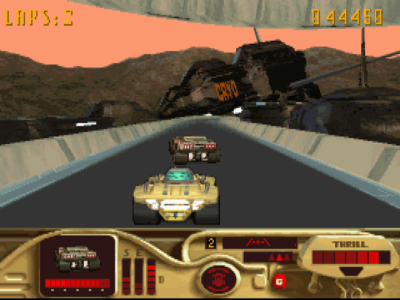
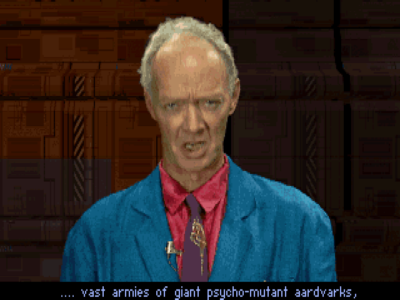
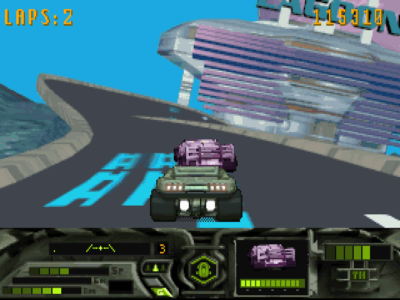

 Posts
Posts